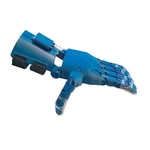Self-suspending below-elbow sockets methodology
This is a methodology developed by Jon Schull and me at the re-NABLE Vertus Lab over the summer of 2018. The methodology basically allows you to make a well-suspended socket using either the 3D-printing & scanning method, or a more hands-on method involving hot glue & soda bottles. It is a combination of socket principles used by qualified Prosthetists clinically and the methods & materials more suited to volunteers around the world. It mainly seeks to solve the problem of below-elbow (trans-radial) e-NABLE devices not being well suspended on the user’s residual arm. Note that this self-suspending socket cannot be used with an elbow-powered e-NABLE DEVICE, but should instead be used with a passive/motorised hand such as the Gripper Hand (credits to Skip & Jon’s design team).

Why a self-suspending socket? It allows you to move your elbow without triggering unwanted movements in the prosthetic hand.
Why a passive/motorised hand instead of an elbow-powered one? Elbow-powered hands are often inefficient because the elbow has a limited range of motion, and the cable movement is often too weak to have real functional benefits. Also, it removes the stress of triggering unwanted hand movements by moving the elbow!
Why THIS method of suspension? If done right, i.e. possibly a few iterations of the socket to get the best fit, same as in Prosthetic clinics, it suspends really well! Good suspension & total contact = close to 100% of your movement being translated into movement of the hand device, giving you increased function.
To elaborate, the self-suspending socket design used is the Strathclyde Supra-Olecranon Socket (SSOS), which is can be used for both short congenital fleshy residuums, and mid-long residuums acquired mainly through trauma. It suspends via 2 main mechanisms: total contact & slight tissue constriction through accurate shape capture of one’s residuum, and suspending above the bony prominence around the elbow.
Jon and I wanted to make this socket design usable by volunteers from varied backgrounds - those with 3D scanners & printers, and those with very limited resources. Hence, we decided to make the elbow self-suspension parts of the socket into a pre-fabricated piece - a sizeable elbow cap that should fit most people’s elbows. This is available in a STL file, and also made using physical hot glue. The elbow cap STL file can be combined with a 3D scan of one’s residuum (instructions provided), and then 3D-printed. The hot glue elbow cap can be used to cast and produce a hot-glue & plastic soda bottle socket (instructions provided), which can then be attached to a Gripper hand.

That’s the gist of the concept, please go to the google drive [link](https://drive.google.com/open?id=1AB6wSnTOVVz3a-NA5eVPFkRrQzvtP4FT) to access the files:
* Contents of the drive:
* Elbow cap stl file! It’s basically a stl file of the elbow bit of the socket, with suspension areas and relief areas for bones. You can join it to a 3D scan of a residual arm, and make your own sockets of the SSOS design.
* A few sockets stl files for reference. Print at 2mm thickness, 100% infill, make sure supports are well placed with less distance to printout as there are some tricky areas that screw up easily, and basically change all other possible settings when printing to decrease layer adhesion/failure. Longer arms can have some strategic cutouts (see Brent.stl), not for small fleshy arms (see other 2 stl files).
* Instructions pdf for how to join the scan and the elbow cap file.
* an ICRC document on how the Red Cross clinics manufacture their trans radial sockets. Good pictures in there of what a socket can look like.
* The dissertation on this project that I wrote with the help of Jon and my supervisor. Some data was obtained from the Red Cross (ICRC), and because permission was not given to release the numbers, I have blacked them out. The discussion points are still there though.
Finally, mega-thanks to the e-NABLE Loomio fund for sponsoring $1200 towards the man-hours put towards the conceptualisation of this project and some consultation work that I did. The entire sum of money was later put towards the setting up of Strathclyde Handprints, a University of Strathclyde e-NABLE chapter that has a powerhouse of Prosthetics students and engineering students. You can visit them at [link](https://www.facebook.com/strathclydehandprints/) for help on Prosthetics student consultation matters. I have since graduated and left the University, but the succeeding team is very capable!
Hope that was comprehensive, you can email me directly at chang.liu0496@gmail.com if needed, I’ll be happy to help!



Jon Schull · · Last updated Mar 7, 2021 - 4:04 PM